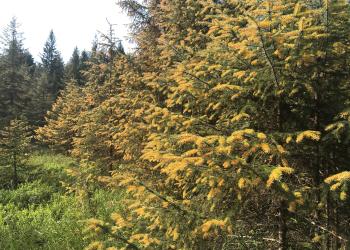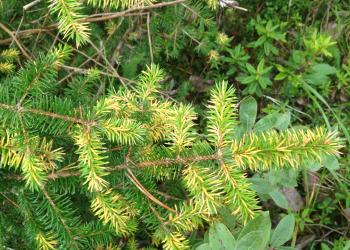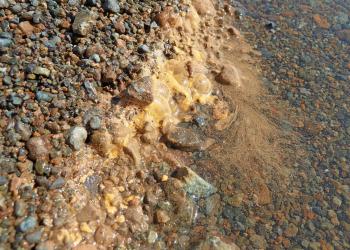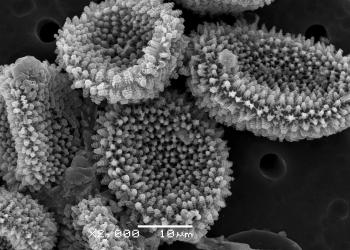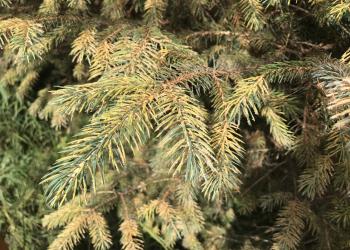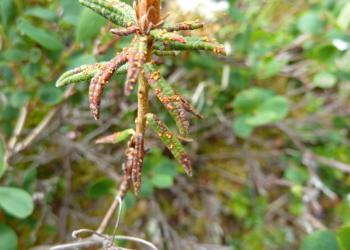Spruce Needle Rusts
Chrysomyxa ledicola (Peck) Lagerh.
Ceropsora weirii (H.S. Jacks.) Aime & McTaggart (=Chrysomyxa weirii)
Host(s) in Alaska:
Sitka spruce (Picea sitchensis)
white spruce (P. glauca)
black spruce (P. mariana)
Labrador tea (Rhododendron groenlandicum, formerly Ledum); alternate host
Habitat(s): Spruce needle rust (C. ledicola) occurs on current-year spruce needles & Labrador tea leaves. Spring spruce needle rust (C. weirii) occurs on one-year-old spruce needles (no alternate host).
General Distribution in Alaska: Throughout the range of hosts statewide
Elevated spruce needle rust disease levels were observed in some locations in Southcentral and Interior Alaska, especially areas mapped during aerial detection survey. Spring spruce needle rust was less common in Southeast Alaska compared to 2023.
Last year, significant damage from Chrysomyxa ledicola was detected on the Kenai Peninsula and in the Matanuska and Copper River Valleys. About 8,200 acres of damage were mapped in Southcentral during the aerial detection survey: near the confluence of the Copper and Chinita Rivers, along the Matanuska-Susitna River between Palmer and Matanuska Glacier State Recreation Site, and on the southern Kenai Peninsula.
2024 Ground Detection Survey Observations: Of 28 C. ledicola observations, 7 were on white spruce between the Alaska Range and the Kenai Peninsula, while 21 were on Sitka spruce near Cordova, Juneau, Petersburg, and Ketchikan. Three observations of C. weirii were found on Sitka spruce near Juneau and Wrangell.
2024 ADS Observations: Just under 300 acres of spruce needle rust were mapped statewide, all in Southcentral (Kenai Peninsula east of Happy Valley) and Interior Alaska (Alaska Range south of Fort Greely).
2024 iNaturalist Observations: 13 C. ledicola observations from north of Fairbanks to the Alaska Peninsula, as well as near Sitka and Petersburg in Southeast Alaska.
Spruce needle rust (Chrysomyxa ledicola) has historically been observed throughout much of Alaska’s spruce forests (Detection Map). This disease rarely results in tree mortality, but whole needle cohorts can be missing on trees and in locations with recent severe disease. Elevated disease levels were noted annually from 2017 to 2020, with a lull in disease activity until 2023. Ceropsora weirii, another less common and less damaging spruce needle rust in Alaska, is occasionally observed on one-year-old needles in spring. It has been documented in coastal forests from the Kenai Peninsula to Prince of Wales Island (Detection Map).

There has been a history of large spruce needle rust outbreaks in Alaska. A major outbreak was aerially mapped across 116,000 acres in Western Alaska in 2019. The disease was also prevalent in 2020 but was not quantified by aerial survey. In 2012, large outbreaks were reported in Lake Clark National Park, Katmai National Park, and the Kenai Peninsula, and notable needle rust also occurred in Southeast Alaska. In 2011, large quantities of rust spores washed ashore near the village of Kivalina in northwestern Alaska. This was somewhat mysterious since spruce is locally uncommon but found upriver, and no ground-checks of spruce could be made at the time. Significant spruce needle rust outbreaks also occurred in 2007 (Southeast Alaska) and 2008 (Interior Alaska). Click here for a summary of historic spruce needle activity and outbreak information from annual Forest Health Conditions in Alaska reports from 1969-2001.
Hennon, P. E. 2001. Spruce Needle Rust. USDA Forest Service Leaflet R10-TP-99. USDA Forest Service Region 10. Available here.
Heavily infected spruce trees have a distinctive orange tinge when the rust is fruiting on the needles in summer. However, sometimes trees are not obviously infected despite abundant orange spores on lake surfaces. Outbreaks are triggered by cool, wet weather in May, when fungal spores from Labrador tea (the alternate host) infect newly emerging spruce needles. Trees damaged by spruce needle rust are seldom killed, since damage is restricted to current-year needles, and the conditions for severe infection usually do not occur in the same location in consecutive years. Infected trees may be stressed or experience growth loss, but these impacts have not been quantified.

Spruce needle rust disease information is largely qualitative and comes from ground observations made by Forest Health Protection staff, as well as land managers and the general public (disease signs and symptoms are easily identified). Occasionally, when disease severity is exceptional, the disease can be mapped by aerial survey.

Content prepared by Robin Mulvey, Forest Health Protection, robin.mulvey@usda.gov.








